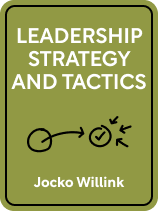

This article is an excerpt from the Shortform book guide to "Leadership Strategy and Tactics" by Jocko Willink. Shortform has the world's best summaries and analyses of books you should be reading.
Like this article? Sign up for a free trial here.
Want to know how to empower your team? Why is it important to empower teams?
Author Jocko Willink developed a series of leadership principles based on his 20 years of experience as a U.S. Navy SEAL. According to him, by learning how to empower your team, you’ll elevate your team members to success by enabling them to become leaders themselves.
Keep reading to learn how to empower your team to lead, according to Willink’s advice.
Empowering Your Team
According to Jocko Willink, your team is held together by relationships, and relationships are built on trust. Without relationships, you simply won’t have a team to lead. To build good relationships with people, Willink says you have to extend trust to your team by learning how to empower your team, which is accomplished by communicating regularly, and by always telling the truth.
(Shortform note: How do good relationships improve your team? Research shows that good relationships improve your team by increasing everyone’s creativity, collaboration, and productivity. Additionally, people who feel they have good relationships with work colleagues feel more satisfied with their jobs, are less likely to experience burnout, and are more likely to stay with their team long-term.)
Willink’s Advice
Let your team know what needs to be done and why it matters to your shared mission, then give them freedom to decide how to do it. Willink claims that by trusting your team with opportunities to lead, you’ll inspire them to reciprocate and trust you. For example, let’s say you give your team the responsibility of organizing a client event. Tell your team that you want to make your guests feel welcome and proud to be working with your company (this is what needs to be done). Then, explain why this is important: These clients are major partners with your organization and provide significant funds to grow the company. From there, let your team come up with the plan, or the how.
In addition to building trust, learning how to empower your team has other benefits:
- This strategy will increase your team’s commitment to the mission because they’ll have a sense of responsibility for the plan. This is because people tend to think their own plans are best. If your own plan has a problem, you’re more inclined to solve it, whereas if there’s a problem with someone else’s plan, you’re likely to blame them instead of looking for solutions.
- By letting your team take on responsibilities, they develop leadership skills. By contrast, if you solve all of their problems, you’ll stunt their growth.
- By designating duties to other people, you free yourself up to handle bigger-picture problems and support the team on a greater scale.
Here are a few things to keep in mind as you designate leadership roles to other people:
- If the plan your team comes up with is good enough to get the job done, go with it.
- If the plan your team comes up with is less than sufficient, respectfully suggest improvements or ask questions about the plan until your team realizes its shortcomings.
- In urgent and consequential cases, or when your team is indecisive about something, you may have to make a more immediate decision. According to Willink, if you normally allow your team the freedom to shape plans as they see fit, they’ll respect and follow you in the rare moments when you make executive decisions.
| Empower Your Children to Make Decisions Willink’s advice on how to empower your team may be just as applicable to leading your children as it is to leading the adults on your team. As with your team, encouraging your children to make decisions helps them develop critical thinking skills, form trusting relationships, determine their values, and build resilience. It can be tempting to make decisions for your children, especially when they’re indecisive or you think they lack the experience or knowledge to make the right choice. However, they’ll only become better decision makers through practice. You can help a child of any age make decisions by teaching them the following: – Making a wrong decision isn’t the end of the world. Mistakes happen and can be fixed together, so it’s okay if you don’t choose the best option at first. – Thinking longer and harder won’t make the decision any easier. Sometimes you have to go with your gut because over-analyzing causes more problems. – It’s okay to have mixed feelings about your decision. With every choice you make, you have to give something else up, and that can feel bad. It doesn’t mean you’re making the wrong choice. As you expand your child’s range of freedom according to their maturity, they’ll probably make a lot of bad decisions. However, they’ll learn that their decisions have consequences and a bit of sting will help them steer clear of similarly poor choices in the future. When your child’s decision-making skills are eventually challenged by self-doubt or the influence of trouble-making peers, encourage them by letting them know you trust in their ability to make good choices. Similar to Willink’s strategy, extending trust will motivate your child to trust you in return. |
A Note About Empowering Your Team to Cultivate Self-Discipline
Just as it’s useful to know how to empower your team, it’s also beneficial to get your team members to develop self-discipline. External discipline (i.e. delivering a command) may get your team to do the bare minimum of what’s required to achieve a task, but it won’t inspire maximal effort. On the other hand, self-discipline is an internal force that drives your behavior and gives you a sense of personal control over what you’re doing. This sense of ownership inspires more commitment and effort to succeed.
To cultivate self-discipline in your team, explain why your request matters for their own success and the success of the team’s mission. If this doesn’t work, you may have to apply external discipline by ordering your team to complete necessary tasks. Ideally, your team will eventually realize the benefits of the forced discipline for themselves (such as pride in their results) and adopt the practice voluntarily.
| The Relationship Between Motivation, Habits, and Self-Discipline Which is more important for self-discipline: motivation or good habits? According to psychologists, the two may actually go hand-in-hand. Research shows that intrinsic motivations are more effective than external motivations for developing successful habits, and having successful habits may drive self-discipline. Extrinsic motivation is similar to the external discipline that Willink describes: a drive based on external reward or punishment. For example, a monthly bonus you’re trying to earn or your fear of disappointing your boss after she gives you a project to do. In contrast, intrinsic motivation is your drive to do what you innately enjoy or are interested in. In a study observing the effects of different motivation sources on long-term weight loss habits, external motivation was shown to be short-lived and ineffective, while intrinsic motivation was long-lasting and effective. Based on this research, a clinical nutritionist makes the case that intrinsic motivation and discipline are required to reach your goals and achieve long-lasting health. In this view, discipline is essential to perform the daily habits that lead you to accomplish your goals. Similar to Willink’s theory, the clinical nutritionist’s view is that intrinsic motivation may form after you perform a habit over time and discover something about it you enjoy. The difference is that Willink says someone’s internal drive to do something will develop once they recognize its benefits or develop pride, whereas the nutritionist’s view is that you’ll develop self-sustaining behavior once you find something in it you enjoy. |

———End of Preview———
Like what you just read? Read the rest of the world's best book summary and analysis of Jocko Willink's "Leadership Strategy and Tactics" at Shortform.
Here's what you'll find in our full Leadership Strategy and Tactics summary:
- A former US Navy SEAL's advice on how to be a good leader
- Three ways you can practice humility and earn your team’s respect
- Why you must always tell the truth, even when it's harsh






